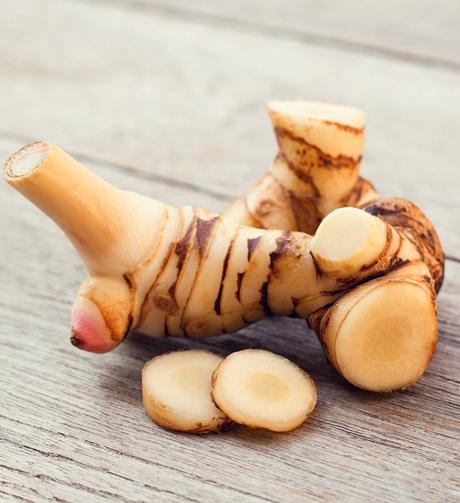
Galangal is a type of spicy root that is commonly used in Asian cuisine and is a staple in Thai foods. It has sharp spicy flavors with hints of peppery taste and a distinctive aroma. Galangal also offers lots of health benefits such as boosting the immune system, protecting heart health, preventing certain infections, and combating cancer.
Galangal comes in various types and is easily available in most Asian specialty stores. But, if you can't find it, don't worry. While galangal does have a unique flavor, these galangal substitutes can help you mimic its wonderful flavor profile to near perfection.
1. Fingerroot
Fingerroot belongs to the same botanical family as galangal and ginger. It looks like long carrot-like fingers and has brownish-orange hues, a mild aroma, and a pungent flavor that tastes more like ginger than galangal. Fingerroot is a warming spice like galangal but is less pungent.
Fingerroot has a neutralizing effect, making it a popular ingredient to replace galangal in many seafood dishes. It will help minimize excessive the other overpowering flavors in Thai and Asian cuisines and add a light peppery touch. When replacing galangal, remember that fingerroot tends to be spicier than galangal. So, it would be a good idea to start with a small amount and adjust to taste.
1 teaspoon fresh galangal = 3/4 to 1 teaspoon fingerroot.
2. Ginger
Ginger belongs to the same family as galangal. It looks and tastes similar to galangal and is a staple ingredient in various cuisines around the world. Fresh ginger has a mild sweetness to it and a robust aroma that lends itself beautifully to dishes.
You can use grated, minced, diced, or chopped ginger in place of galangal to marinate meat and fish or add it to stir-fries, soups, and stews to infuse them with rich flavors and aroma. Keep in mind that ginger has a slightly spicy flavor, so use less to avoid overpowering your recipe's delicate flavors. Ginger also does not have galangal's citrus flavor, so you will need to add some lime zest/lime leaves to get the perfect flavor.
1 tablespoon fresh galangal = 1/2 to 3/4 tablespoon ginger + 1/4 teaspoon lemon juice.
3. Galangal Paste
Galangal has a strong, almost fiery flavor. That is why it is mixed with condiments and spices like ginger, citric acid, pepper, salt, and sugar to it more palatable. Unlike fresh galangal, galangal paste is easily available in most stores. But, if you'd rather skip all the extra ingredients, you can also make your own galangal paste with fresh galangal and vegetable oil.
Galangal paste is an easy replacement for fresh galangal in sauces, marinades, stir-fries, and more. Just keep in mind that it contains other ingredients, so it won't have a strong galangal paste and additional flavors. You may also have to monitor the amount of other spices and condiments in your recipe to balance out the flavors.
1 inch of fresh galangal = 1 teaspoon galangal paste.
4. Kaffir Lime Leaves
Kaffir lime leaves, a common ingredient in Asian cooking, have a slightly bitter, citrus flavor with notes of spiciness. They're intensely flavored, so you'll want to watch how much you use to avoid overpowering the dish.
To use, simply cut up or tear kaffir lime leaves before adding them to your meals to inject wonderful citrus flavors. You can also finely chop them, which makes them edible, to add in stir-fries for an amazing lime-like flavor with hints of spice. It will also help replace the fishy smell in seafood dishes and can be used as a garnish for a pop of color.
To substitute, start with a small amount and add more after tasting.
5. Lemongrass
Lemongrass is a type of herb frequently used to flavor Vietnamese and other Asian cuisines. It has a lemon-like citrusy flavor with a slightly sharp and tangy taste and hints of hotness, which is quite similar to the flavor profile of galangal.
You can use the refreshing, slightly acidic lemongrass in various dishes like soups and stews to enhance their flavors and inject some brightness into the dish. The fresh aroma of lemongrass will also lend itself beautifully to curries and stir-fries and will even work exemplary well in teas.
1 teaspoon fresh galangal = 1 1/2 teaspoon lemongrass.
6. White Pepper
White and black pepper both make wonderful galangal substitutes. But, because white pepper is less pungent and has more heat, it offers a more similar flavor to the original ingredient. White pepper is best used in seafood, where it flavors light-colored dishes without changing the overall appearance of the dish.
You can use white pepper to replace galangal in marinades, stews, and soups to infuse them with an intense hot taste that will get your taste buds going. While substituting, keep in mind that white pepper is hotter than galangal, so using too much can overpower the recipe's delicate flavors. Additionally, because it lacks the citrusy flavor of galangal, it would be wise to restrict its use to heat-based dishes.
To substitute, start with just a pinch or two, then taste test and add more if needed.
7. Horseradish
Horseradish is a root vegetable that belongs to the same family as mustard and wasabi. It has a strong and spicy taste that can elevate any dish. Horseradish shares a lot of similarities to galangal in terms of flavor and aroma and can thus be used to replace galangal in a range of recipes.
You can grate horseradish and mix it with other sauces and condiments to flavor meat and fish dishes. You can also add a little amount of grated horseradish in soups and stews for a powerful flavor kick.
To substitute, start with a small amount, then taste and adjust to your preference.
